Research on Annual Thermal Environment of Non-Hvac Building Regulated by Window-to-Wall Ratio in a Chinese City (Chenzhou)
Abstract
1. Introduction
2. Research Methods
2.1. Evaluation Index
2.2. Study Model
2.2.1. Technical Model
2.2.2. Case Model
2.3. Window-to-Wall Ratio Settings
2.4. Sources and Settings of Meteorological Data
3. Results and Discussion
3.1. The Mean Monthly Effects of WWRs on Indoor Air Temperature
3.2. The Distribution of Annual Thermal Comfort
3.3. The Total Improvement of Indoor Air Temperature Perception Caused by the WWR
4. Conclusions
Author Contributions
Funding
Acknowledgments
Conflicts of Interest
References
- Bilgen, S. Structure and environmental impact of global energy consumption. Renew. Sustain. Energy Rev. 2014, 38, 890–902. [Google Scholar] [CrossRef]
- Fan, J.-L.; Yu, H.; Wei, Y.-M. Residential energy-related carbon emissions in urban and rural China during 1996–2012: From the perspective of five end-use activities. Energy Build. 2015, 96, 201–209. [Google Scholar] [CrossRef]
- Shafaghat, A.; Keyvanfar, A.; Manteghi, G.; Lamit, H.B. Environmental-conscious factors affecting street microclimate and individuals’ respiratory health in tropical coastal cities. Sustain. Cities Soc. 2016, 21, 35–50. [Google Scholar] [CrossRef]
- Mauree, D.; Coccolo, S.; Perera, A.T.D.; Nik, V.; Scartezzini, J.-L.; Naboni, E. A new framework to evaluate urban design using urban microclimatic modeling in future climatic conditions. Sustainability 2018, 10, 1134. [Google Scholar] [CrossRef]
- Liu, Z.; Wu, D.; Li, J.; Yu, H.; He, B. Optimizing building envelope dimensions for passive solar houses in the Qinghai-Tibetan region: Window to wall ratio and depth of sunspace. J. Therm. Sci. 2019, 28, 1115–1128. [Google Scholar] [CrossRef]
- Zhai, Y.; Wang, Y.; Huang, Y.; Meng, X. A multi-objective optimization methodology for window design considering energy consumption, thermal environment and visual performance. Renew. Energy 2019, 134, 1190–1199. [Google Scholar] [CrossRef]
- Costanzo, V.; Evola, G.; Marletta, L. Thermal and visual performance of real and theoretical thermochromic glazing solutions for office buildings. Sol. Energy Mater. Sol. Cells 2016, 149, 110–120. [Google Scholar] [CrossRef]
- Raji, B.; Tenpierik, M.J.; Dobbelsteen, A.V.d. Early-stage design considerations for the energy-efficiency of high-rise office buildings. Sustainability 2017, 9, 623. [Google Scholar] [CrossRef]
- Acosta, I.; Campano, M.Á.; Molina, J.F. Window design in architecture: Analysis of energy savings for lighting and visual comfort in residential spaces. Appl. Energy 2016, 168, 493–506. [Google Scholar] [CrossRef]
- Kheiri, F. A review on optimization methods applied in energy-efficient building geometry and envelope design. Renew. Sustain. Energy Rev. 2018, 92, 897–920. [Google Scholar] [CrossRef]
- Inanici, M.N.; Demirbilek, F.N. Thermal performance optimization of building aspect ratio and south window size in five cities having different climatic characteristics of Turkey. Build. Environ. 2000, 35, 41–52. [Google Scholar] [CrossRef]
- Amaral, A.R.; Rodrigues, E.; Gaspar, A.R.; Gomes, Á. A thermal performance parametric study of window type, orientation, size and shadowing effect. Sustain. Cities Soc. 2016, 26, 456–465. [Google Scholar] [CrossRef]
- Ma, P.; Wang, L.-S.; Guo, N. Maximum window-to-wall ratio of a thermally autonomous building as a function of envelope U-value and ambient temperature amplitude. Appl. Energy 2015, 146, 84–91. [Google Scholar] [CrossRef]
- Shaeri, J.; Habibi, A.; Yaghoubi, M.; Chokhachian, A. The optimum window-to-wall ratio in office buildings for hot‒humid, hot‒dry, and cold climates in Iran. Environments 2019, 6, 45. [Google Scholar] [CrossRef]
- Yaghoobian, N.; Kleissl, J. An indoor-outdoor building energy simulator to study urban modification effects on building energy use—Model description and validation. Energy Build. 2012, 54, 407–417. [Google Scholar] [CrossRef]
- Tombazis, A.; Preuss, S. Design of passive solar buildings in urban areas. Sol. Energy 2001, 70, 311–318. [Google Scholar] [CrossRef]
- Freitas, S.; Catita, C.; Redweik, P.; Brito, M.C. Modelling solar potential in the urban environment: State-of-the-art review. Renew. Sustain. Energy Rev. 2015, 41, 915–931. [Google Scholar] [CrossRef]
- Gijón-Rivera, M.; Xamán, J.; Álvarez, G.; Serrano-Arellano, J. Coupling CFD-BES Simulation of a glazed office with different types of windows in Mexico City. Build. Environ. 2013, 68, 22–34. [Google Scholar] [CrossRef]
- Marino, C.; Nucara, A.; Pietrafesa, M. Does window-to-wall ratio have a significant effect on the energy consumption of buildings? A parametric analysis in Italian climate conditions. J. Build. Eng. 2017, 13, 169–183. [Google Scholar] [CrossRef]
- Fayaz, R.; Kari, B.M. Comparison of energy conservation building codes of Iran, Turkey, Germany, China, ISO 9164 and EN 832. Appl. Energy 2009, 86, 1949–1955. [Google Scholar] [CrossRef]
- Tsoka, S.; Tsikaloudaki, A.; Theodosiou, T. Analyzing the ENVI-met microclimate model’s performance and assessing cool materials and urban vegetation applications—A review. Sustain. Cities Soc. 2018, 43, 55–76. [Google Scholar] [CrossRef]
- Dell’Accio, F.; Di Tommaso, F. On the hexagonal Shepard method. Appl. Numer. Math. 2020, 150, 51–64. [Google Scholar] [CrossRef]
- Ji, W.; Cao, B.; Geng, Y.; Zhu, Y.; Lin, B. Study on human skin temperature and thermal evaluation in step change conditions: From non-neutrality to neutrality. Energy Build. 2017, 156, 29–39. [Google Scholar] [CrossRef]
- Potchter, O.; Cohen, P.; Lin, T.-P.; Matzarakis, A. Outdoor human thermal perception in various climates: A comprehensive review of approaches, methods and quantification. Sci. Total Environ. 2018, 631, 390–406. [Google Scholar] [CrossRef] [PubMed]
- Liu, W.; Zhang, Y.; Deng, Q. The effects of urban microclimate on outdoor thermal sensation and neutral temperature in hot-summer and cold-winter climate. Energy Build. 2016, 128, 190–197. [Google Scholar] [CrossRef]
- Cui, Y.; Yan, D.; Chen, C.-F. Exploring the factors and motivations influencing heating behavioral patterns and future energy use intentions in the hot summer and cold winter climate zone of China. Energy Build. 2017, 153, 99–110. [Google Scholar] [CrossRef]
- Guo, S.; Yan, D.; Peng, C.; Cui, Y.; Zhou, X.; Hu, S. Investigation and analyses of residential heating in the HSCW climate zone of China: Status quo and key features. Build. Environ. 2015, 94, 532–542. [Google Scholar] [CrossRef]
- Morakinyo, T.E.; Lam, Y.F. Simulation study on the impact of tree-configuration, planting pattern and wind condition on street-canyon’s micro-climate and thermal comfort. Build. Environ. 2016, 103, 262–275. [Google Scholar] [CrossRef]
- Li, J.; Zheng, B.; Shen, W.; Xiang, Y.; Chen, X.; Qi, Z. Cooling and Energy-Saving Performance of Different Green Wall Design: A Simulation Study of a Block. Energies 2019, 12, 2912. [Google Scholar] [CrossRef]
- Szucs, Á.; Gál, T.; Andrade, H. Comparison of measured and simulated mean radiant temperature. Case study in Lisbon (Portugal). Finisterra Rev. Port. Geogr. 2014, 98, 95–111. [Google Scholar] [CrossRef]
- Lee, H.; Mayer, H.; Chen, L. Contribution of trees and grasslands to the mitigation of human heat stress in a residential district of Freiburg, Southwest Germany. Landsc. Urban Plan. 2016, 148, 37–50. [Google Scholar] [CrossRef]
- Bruse, M.; Fleer, H. Simulating surface-plant-air interactions inside urban environments with a three dimensional numerical model. Environ. Model. Softw. 1998, 13, 373–384. [Google Scholar] [CrossRef]
- Zhong, W.; Cao, J.; Xue, J.; Ouyang, J. A 15,400-year record of climate variation from a subalpine lacustrine sedimentary sequence in the western Nanling Mountains in South China. Quat. Res. 2015, 84, 246–254. [Google Scholar] [CrossRef]
- Bitsa, E.; Flocas, H.; Kouroutzoglou, J.; Hatzaki, M.; Rudeva, I.; Simmonds, I. Development of a Front Identification Scheme for Compiling a Cold Front Climatology of the Mediterranean. Climate 2019, 7, 130. [Google Scholar] [CrossRef]
- Xu, X.; Xu, X.; Guan, P.; Ren, Y.; Wang, W.; Xu, N. The cause and evolution of urban street vitality under the time dimension: Nine cases of streets in Nanjing City, China. Sustainability 2018, 10, 2797. [Google Scholar] [CrossRef]
- Li, J.; Heap, A.D. A review of comparative studies of spatial interpolation methods in environmental sciences: Performance and impact factors. Ecol. Inform. 2011, 6, 228–241. [Google Scholar] [CrossRef]
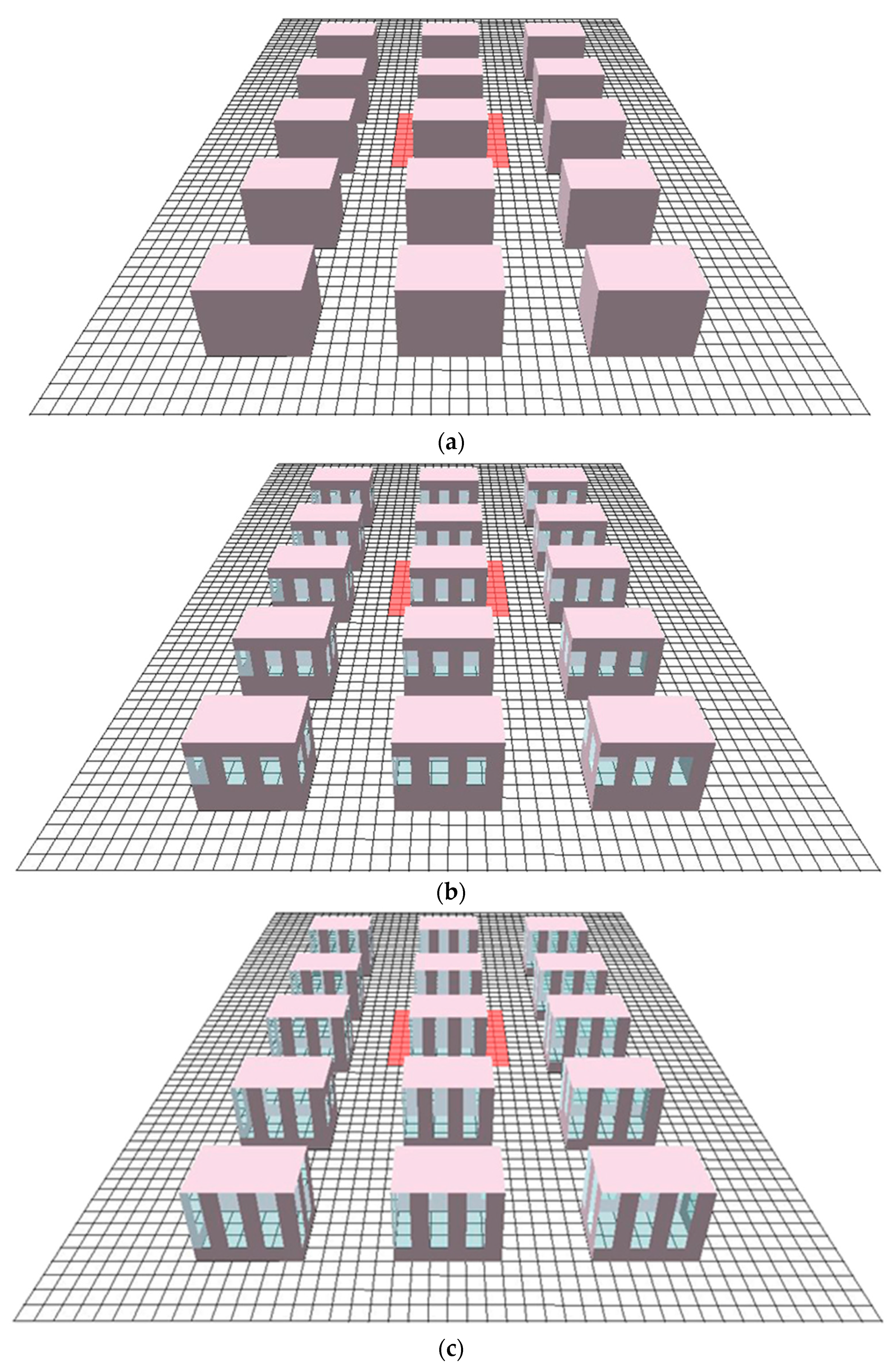
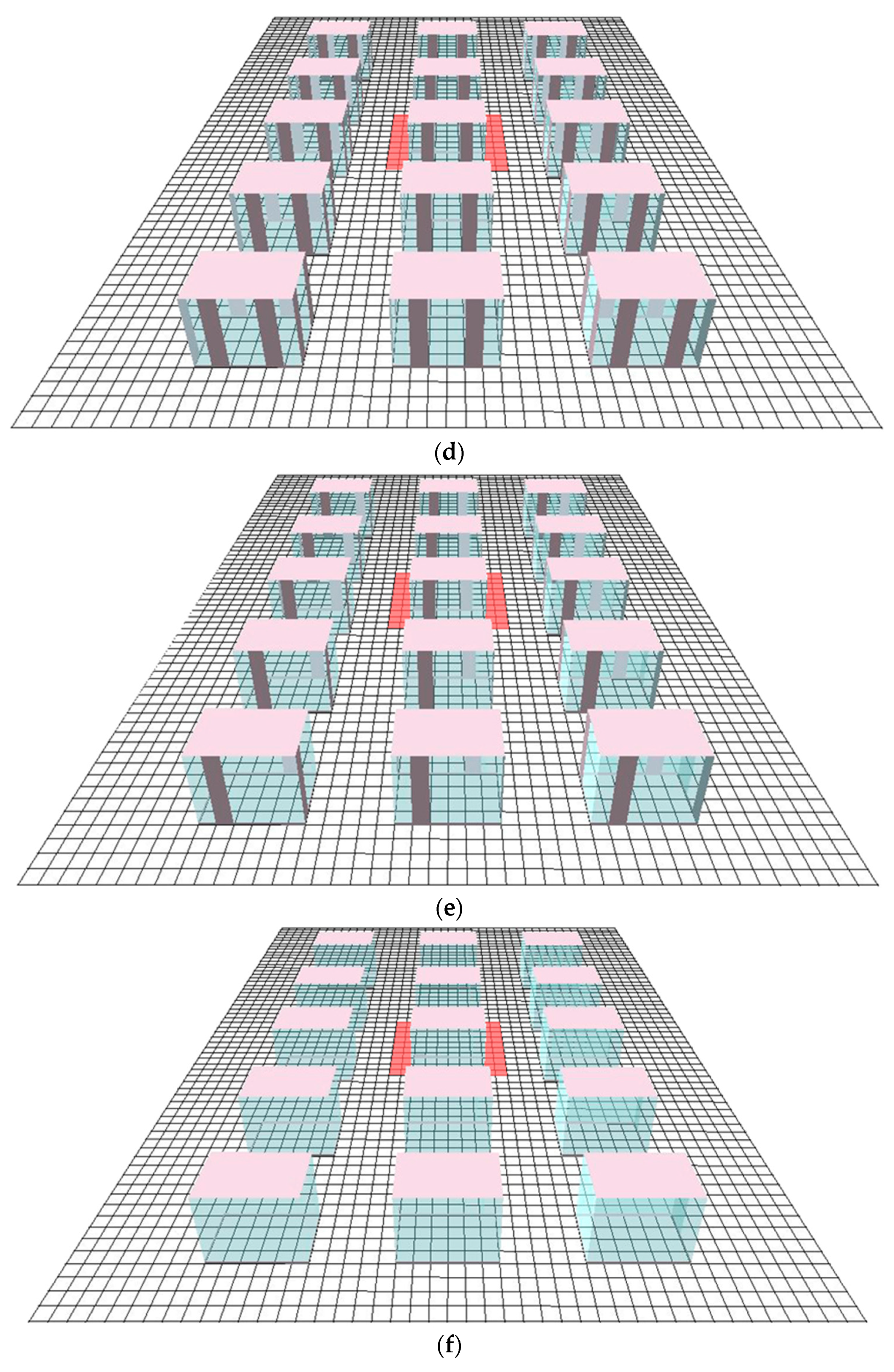
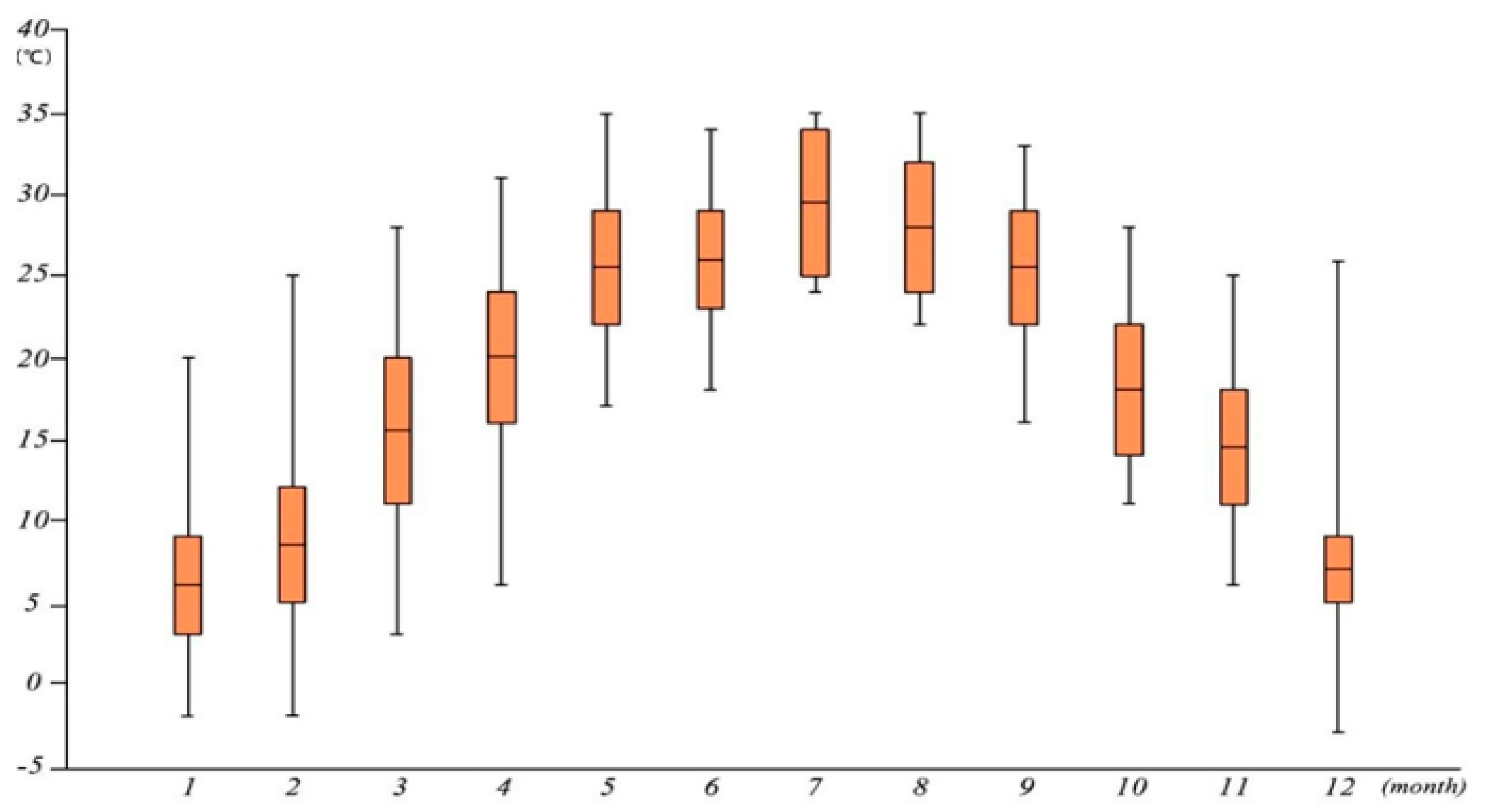
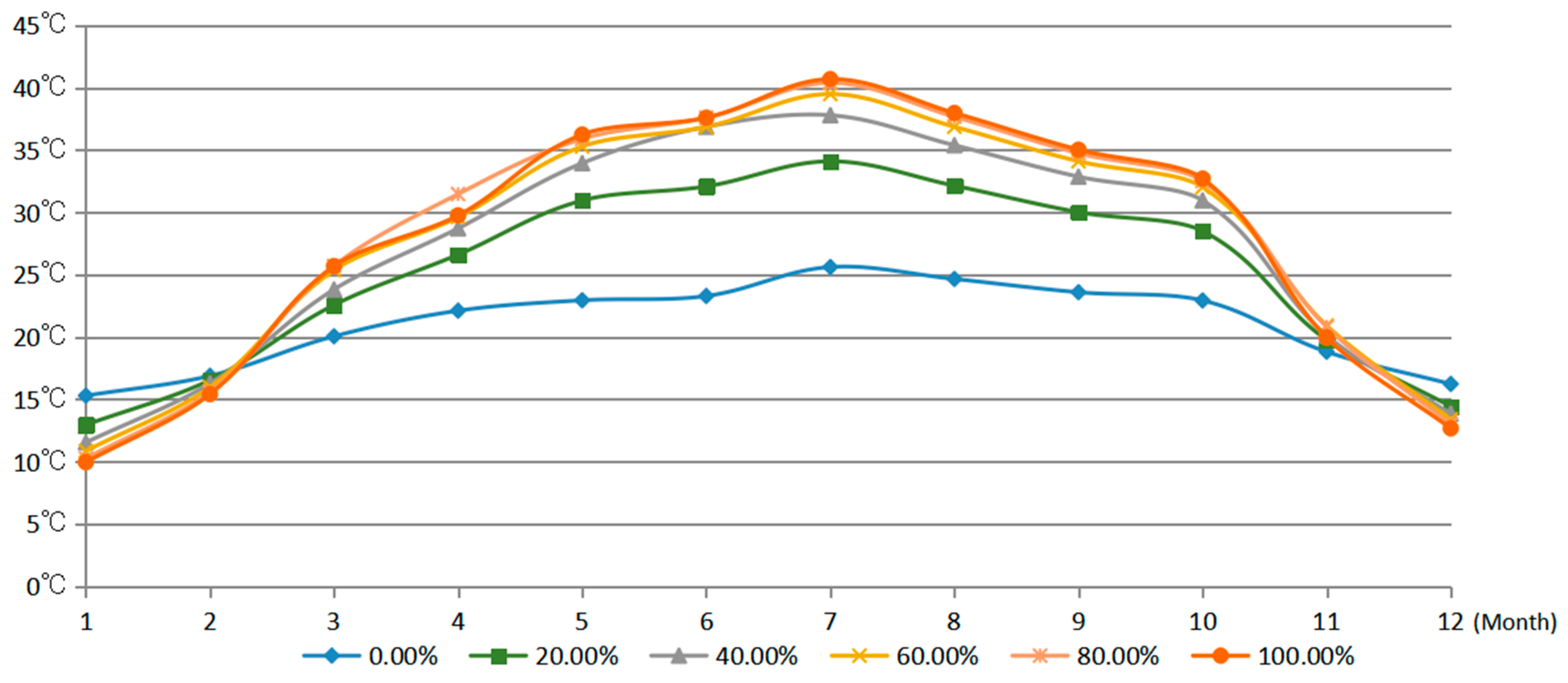
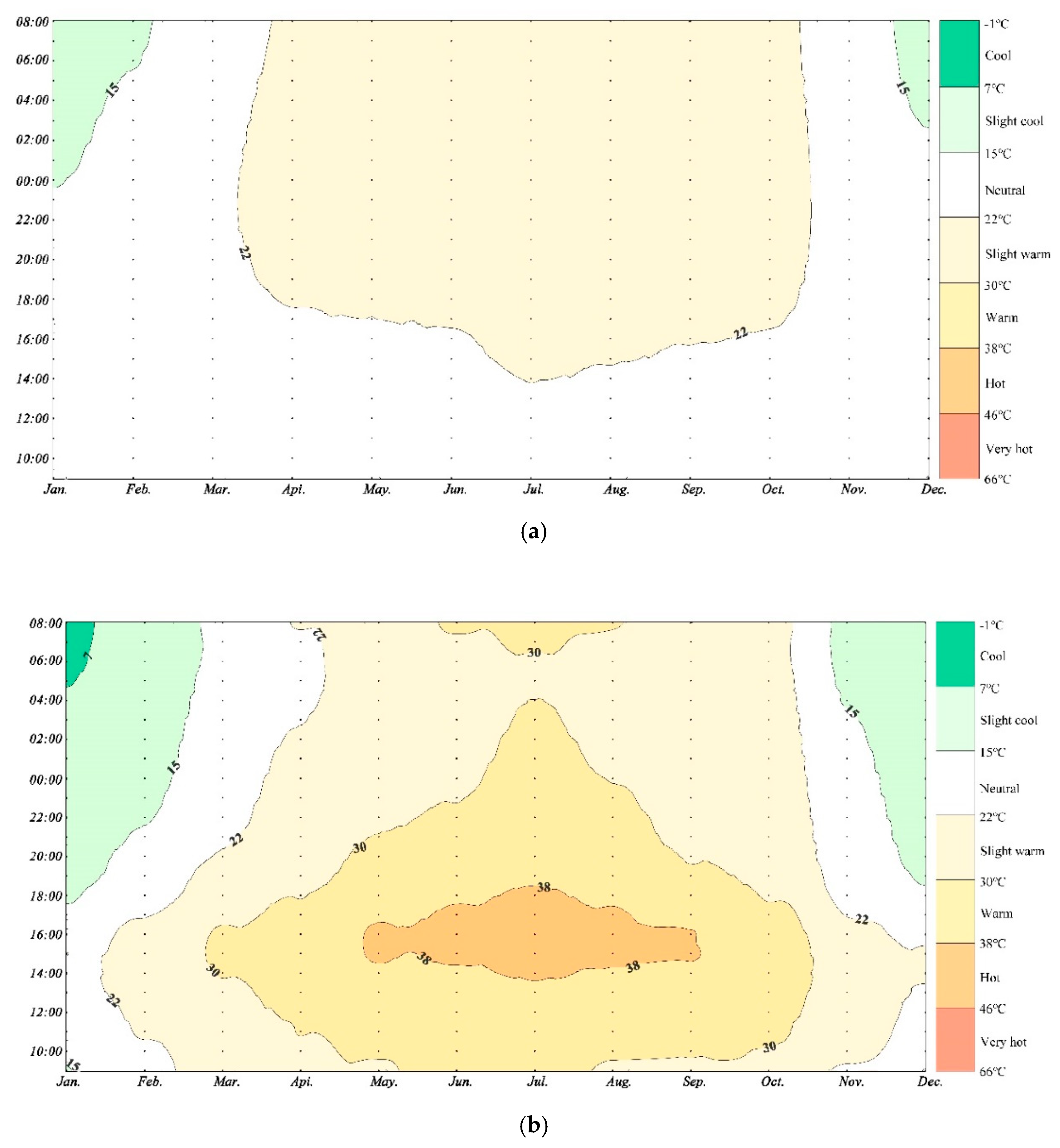

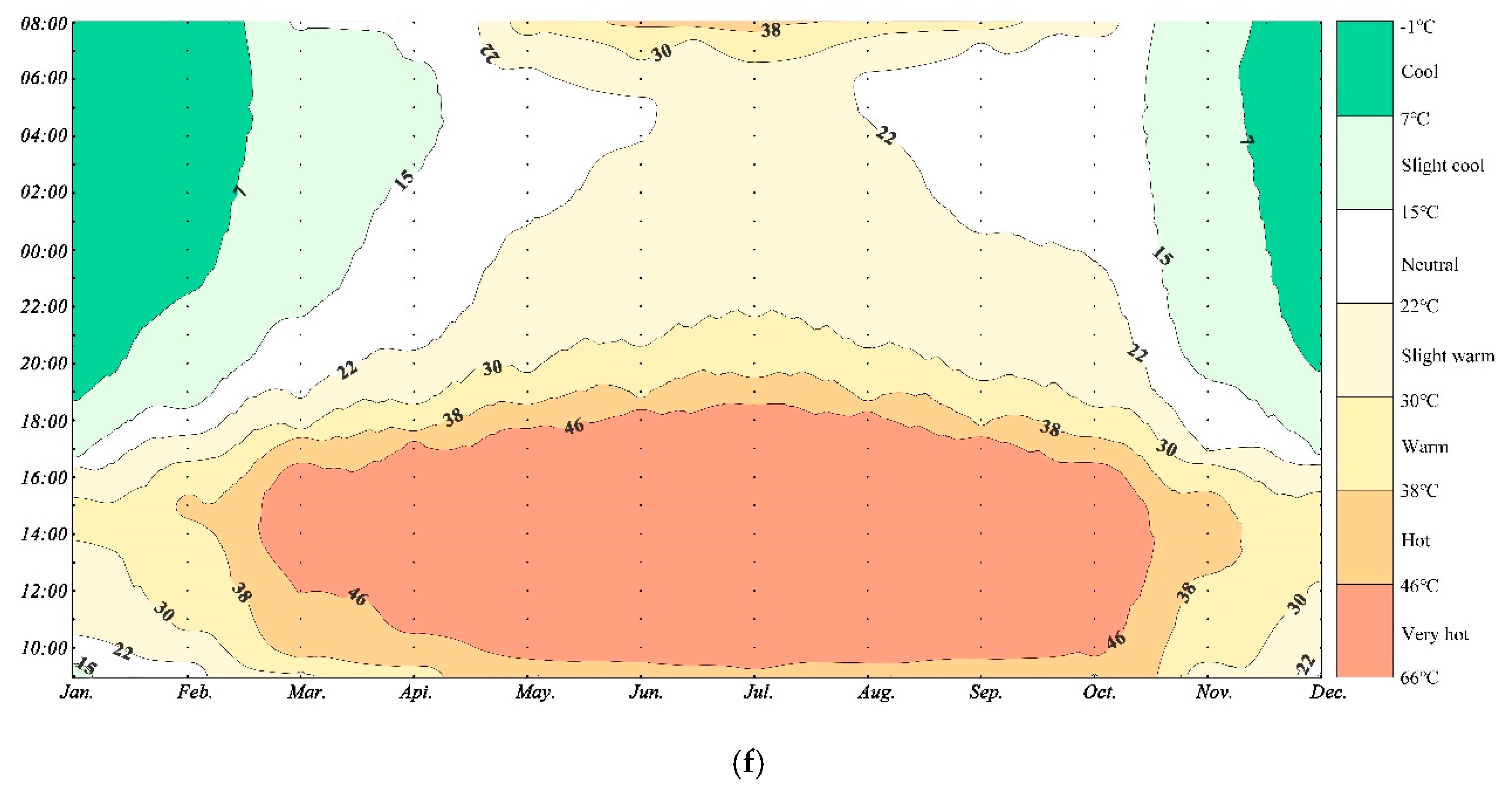
| Thermal Perception | Temperature Range |
|---|---|
| Very cold | <−8 °C |
| Cold | −8–1 °C |
| Slightly cool | −1–7 °C |
| Cool | 7–15 °C |
| Neutral | 15–22 °C |
| Slightly warm | 22–30 °C |
| Warm | 30–38 °C |
| Hot | 38–46 °C |
| Very hot | >46 °C |
| Parameter | Value (Concrete Hollow Brick) | Value (Plexiglass) |
|---|---|---|
| Thickness (m) | 0.30 | 0.05 |
| Absorption (Frac) | 0.70 | 0.90 |
| Transmission (Frac) | 0.00 | 0.05 |
| Reflection (Frac) | 0.30 | 0.90 |
| Emissivity (Frac) | 0.90 | 1500.00 |
| Specific Heat | 840.00 | 0.19 |
| Thermal conductivity (w/m2·k) | 0.86000 | 0.19000 |
| Thermal Conductivity | 0.86 | 1180.00 |
| Density (kg/m3) | 930.00 | 1180.00 |
| Month | Initial Meteorological Parameters | Value | Month | Initial Meteorological Parameters | Value |
|---|---|---|---|---|---|
| January | wind velocity (10 m off the ground) | 1.5 m/s | July | wind velocity (10 m off the ground) | 4.4 m/s |
| wind angle | 0° | wind angle | 135° | ||
| relative humidity | 79% | relative humidity | 67% | ||
| min air temperature | 3 °C | min air temperature | 25 °C | ||
| max air temperature | 9 °C | max air temperature | 34 °C | ||
| February | wind velocity (10 m off the ground) | 1.5 m/s | Agust | wind velocity (10 m off the ground) | 3.3 m/s |
| wind angle | 0° | wind angle | 135° | ||
| relative humidity | 78% | relative humidity | 72% | ||
| min air temperature | 5 °C | min air temperature | 24 °C | ||
| max air temperature | 12 °C | max air temperature | 32 °C | ||
| March | wind speed (10 m off the ground) | 2.5 m/s | September | wind speed (10 m off the ground) | 1.5 m/s |
| wind angle | 75° | wind angle | 45° | ||
| relative humidity | 78% | relative humidity | 75% | ||
| min air temperature | 11 °C | min air temperature | 22 °C | ||
| max air temperature | 20 °C | max air temperature | 29 °C | ||
| April | wind velocity (10 m above the ground) | 4.4 m/s | October | wind velocity (10 m above the ground) | 3.3 m/s |
| wind angle | 125° | wind angle | 15° | ||
| relative humidity | 75% | relative humidity | 74% | ||
| min air temperature | 16 °C | min air temperature | 14 °C | ||
| max air temperature | 24 °C | max air temperature | 22 °C | ||
| May | wind velocity (10 m off the ground) | 5 m/s | November | wind velocity (10 m off the ground) | 3.3 m/s |
| wind angle | 150° | wind angle | 9° | ||
| relative humidity | 76% | relative humidity | 80% | ||
| min air temperature | 22 °C | min air temperature | 11 °C | ||
| max air temperature | 29 °C | max air temperature | 18 °C | ||
| June | wind velocity (10 m off the ground) | 4.4 m/s | December | wind velocity (10 m off the ground) | 1.6 m/s |
| wind angle | 90° | wind angle | 0° | ||
| relative humidity | 76% | relative humidity | 76% | ||
| min air temperature | 23 °C | min air temperature | 5 °C | ||
| max air temperature | 29 °C | max air temperature | 9 °C |
| WWR PT | 0.00% | 20.00% | 40.00% | 60.00% | 80.00% | 100.00% | |
|---|---|---|---|---|---|---|---|
| Very hot | hour | 0.00 | 0.00 | 561.69 | 1391.52 | 1901.81 | 1973.80 |
| % | 0.00 | 0.00 | 6.41 | 15.88 | 21.82 | 22.53 | |
| Hot | hour | 0.00 | 430.36 | 1433.27 | 1094.83 | 763.99 | 721.39 |
| % | 0.00 | 4.91 | 16.36 | 12.50 | 9.31 | 8.24 | |
| Warm | hour | 0.00 | 2577.80 | 1578.07 | 1152.83 | 1022.05 | 959.83 |
| % | 0.00 | 29.43 | 18.01 | 13.16 | 11.70 | 10.96 | |
| Slight | hour | 3842.37 | 3314.50 | 2789.06 | 2522.85 | 2194.80 | 1894.65 |
| % | 43.86 | 37.84 | 31.84 | 28.80 | 24.99 | 21.63 | |
| Neutral | hour | 4645.26 | 1471.29 | 1098.55 | 1094.88 | 1190.46 | 1361.94 |
| % | 53.03 | 16.80 | 12.54 | 12.50 | 14.99 | 15.55 | |
| Slight | hour | 272.37 | 933.57 | 1038.54 | 1025.68 | 1044.55 | 1083.66 |
| % | 3.11 | 10.66 | 11.86 | 11.71 | 11.72 | 12.37 | |
| Cool | hour | 0.00 | 32.48 | 260.82 | 477.40 | 644.99 | 764.73 |
| % | 0.00 | 0.37 | 2.98 | 5.45 | 5.47 | 8.73 |
© 2020 by the authors. Licensee MDPI, Basel, Switzerland. This article is an open access article distributed under the terms and conditions of the Creative Commons Attribution (CC BY) license (http://creativecommons.org/licenses/by/4.0/).
Share and Cite
Li, J.; Zheng, B.; Chen, X.; Zhou, Y.; Rao, J.; Bedra, K.B. Research on Annual Thermal Environment of Non-Hvac Building Regulated by Window-to-Wall Ratio in a Chinese City (Chenzhou). Sustainability 2020, 12, 6637. https://doi.org/10.3390/su12166637
Li J, Zheng B, Chen X, Zhou Y, Rao J, Bedra KB. Research on Annual Thermal Environment of Non-Hvac Building Regulated by Window-to-Wall Ratio in a Chinese City (Chenzhou). Sustainability. 2020; 12(16):6637. https://doi.org/10.3390/su12166637
Chicago/Turabian StyleLi, Jiayu, Bohong Zheng, Xiao Chen, Yihua Zhou, Jifa Rao, and Komi Bernard Bedra. 2020. "Research on Annual Thermal Environment of Non-Hvac Building Regulated by Window-to-Wall Ratio in a Chinese City (Chenzhou)" Sustainability 12, no. 16: 6637. https://doi.org/10.3390/su12166637
APA StyleLi, J., Zheng, B., Chen, X., Zhou, Y., Rao, J., & Bedra, K. B. (2020). Research on Annual Thermal Environment of Non-Hvac Building Regulated by Window-to-Wall Ratio in a Chinese City (Chenzhou). Sustainability, 12(16), 6637. https://doi.org/10.3390/su12166637






